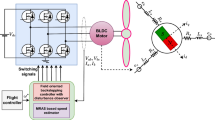Abstract
The increasing demand for high-efficiency greenhouse control systems motivates the interest in ensuring optimal growth climate conditions into the system. The greenhouse climate control is complex because of the strong coupling between the two main controlled variables (temperature and humidity), the time delays present within the control loop and the high nonlinear interaction between the physical and the biological subsystems. In this context, the idea of this work is to improve the robust behavior of the Filtered Smith Predictor (FSP) in an equivalent greenhouse climate model with multiple time delays as a function of the uncertainty degree of the process model to be controlled. An automated tuning technique is proposed for the robustness filter of MIMO-FSP through online estimation of the modeling error. Simulation results show that the proposed technique is able to improve disturbance rejection dynamics while assuring robust stability.













Similar content being viewed by others
References
Aguirre, L. A. (2001). Introduç ao à Identificaç ao de Sistemas: Técnicas Lineares e N ao-Lineares Aplicadas a Sistemas Reais (Introduction to System Identification: linear and nonlinear methods applied to real systems). Belo Horizonte: UFMG.
Albright, L. D., Gates, R. S., Arvanitis, K. G., & Drysdale, A. (2001). Environmental control for plants on Earth and in space. IEEE Control System Magazine, 21(5), 28–47.
Alevisakis, G., & Seborg, D. E. (1973). An extension of the Smith predictor method to multivariable linear systems containing time delays. International Jornal Control, 17(3), 541–551.
Azaza, M., Echaieb, K., Mami, A., & Iqbal, A. (2014). Optimized micro-climate controller of a greenhouse powered by photovoltaic generator. In: Renewable energy congress (IREC), 2014 5th international, pp. 1–5.
Flesch, R. C. C., Torrico, B. C., Normey-Rico, J. E., & Cavalcante, M. U. (2011). Unified approach for minimal output dead time compensation in MIMO processes. Journal of Process Control, 21(7), 1080–1091.
Garrido, J., Vázquez, F., Morilla, F., & Normey-Rico, J. E. (2016). Smith predictor with inverted decoupling for square multivariable time delay systems. International Journal of Systems Science, 47(2), 374–388.
Gonçalves, R., & Santos, T.L.M. (2015). Sintonia automatizada do filtro de robustez para o controle de sistemas com atraso (Automated tuning of robustness filter for control systems with delays). In: XII Simpósio Brasileiro de Automaç ao Inteligente (SBAI).
Gurban, E.H., & Andreescu, G. (2012). Comparison study of \(PID\) controller tuning for greenhouse climate with feedback-feedforward linearization and decoupling. In: System Theory, Control and Computing (ICSTCC), 2012, pp. 1-6.
Jerome, N. F., & Ray, W. H. (1986). High performance multivariable control strategies for systems having time delays. AIChE Journal, 32(6), 914–931.
Landau, I. D., & Zito, G. (2006). Digital control system. Berlin: Springer.
Merle, H. J., & Alan, J. M. (1995). Protected Agriculture: A Global Review. World Bank Technical Paper, 23(15), 157.
Normey-Rico, J. E., & Camacho, E. F. (2007). Control of dead-time processes. London: Springer.
Normey-Rico, J. E., & Camacho, E. F. (2008). Dead-time compensators: A survey. Control Engineering Practice, 16(4), 407–428.
Normey-Rico, J. E., Sartori, R., Veronesi, M., & Visioli, A. (2014). An automatic tuning methodology for a unified dead-time compensator. Control Engineering Practice, 27, 11–22.
Ogunnaike, B. A., & Ray, W. H. (1979). Multivariable controller design for linear systems having multiple time delays. AIChE Journal, 25(6), 1043–1060.
Palmor, Z. J. (1996). Time-delay compensation—Smith predictor and its modifications. In: CRC and IEEE Press, Boca Raton, (pp. 224—237)
Pasgianos, G. D., Arvanitis, K. G., Polycarpou, P., & Sigrimis, N. (2003). A nonlinear feedback technique for greenhouse environmental control. Computers and Electronics in Agriculture, 40, 153–177.
Santos, T. L. M., Flesch, R. C. C., & Normey-Rico, J. L. (2014). On the filtered Smith predictor for MIMO processes with multiple time delays. Journal of Process Control, 24(4), 383–400.
Skogestad, S., & Postlethwaite, I. (2001). Multivariable feedback control: Analysis and design. Hoboken: wiley.
Smith, O. J. M. (1957). Closer control of loops with dead time. Chemical Engineering Progress, 53(5), 217–219.
Acknowledgments
Financial support from the Brazilian funding agencies CAPES and CNPq is gratefully acknowledged.
Author information
Authors and Affiliations
Corresponding author
Rights and permissions
About this article
Cite this article
Giraldo, S.A.C., Flesch, R.C.C. & Normey-Rico, J.E. Multivariable Greenhouse Control Using the Filtered Smith Predictor. J Control Autom Electr Syst 27, 349–358 (2016). https://doi.org/10.1007/s40313-016-0250-6
Received:
Revised:
Accepted:
Published:
Issue Date:
DOI: https://doi.org/10.1007/s40313-016-0250-6




